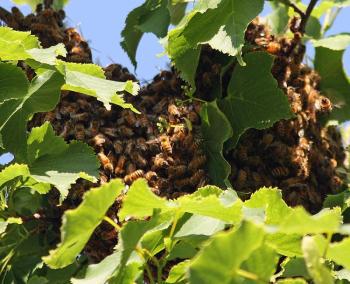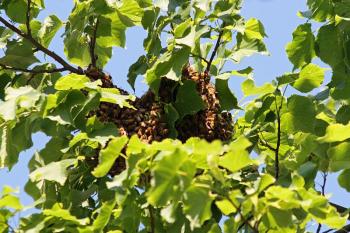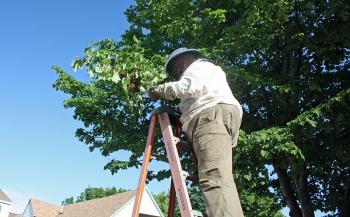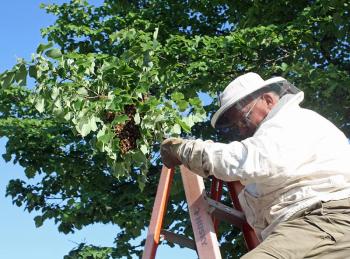Thomaston beekeeper makes quick work of Main Street honeybee swarm in Rockland
 A small honeybee swarm clusters on a tree branch at the corner of Main and Orient streets in downtown Rockland Friday afternoon. (Photo by Holly S. Edwards)
A small honeybee swarm clusters on a tree branch at the corner of Main and Orient streets in downtown Rockland Friday afternoon. (Photo by Holly S. Edwards)
 Peter Lammert of Thomaston grabs gear from his truck after setting up his ladder on Main Street in Rockland around 5 p.m. Friday. (Photo by Holly S. Edwards)
Peter Lammert of Thomaston grabs gear from his truck after setting up his ladder on Main Street in Rockland around 5 p.m. Friday. (Photo by Holly S. Edwards)
 A bundle of honeybees, which swarmed from somewhere nearby, waits in a tree in downtown Rockland while scout bees are out searching for a suitable new home. (Photo by Holly S. Edwards)
A bundle of honeybees, which swarmed from somewhere nearby, waits in a tree in downtown Rockland while scout bees are out searching for a suitable new home. (Photo by Holly S. Edwards)
 After circling around Main Street around 4:30 p.m. Friday, the honeybee swarm settled on this tree in front of Camden National Bank. (Photo by Holly S. Edwards)
After circling around Main Street around 4:30 p.m. Friday, the honeybee swarm settled on this tree in front of Camden National Bank. (Photo by Holly S. Edwards)
 Beekeeper Peter Lammert cuts the branch with the honeybee swarm clinging to it. (Photo by Holly S. Edwards)
Beekeeper Peter Lammert cuts the branch with the honeybee swarm clinging to it. (Photo by Holly S. Edwards)
 A honeybee swarm is docile and easy to handle because they exhibit defensive behavior only when they have a hive to protect. When moving around honeybees, slow and quiet keeps everyone safe. (Photo by Holly S. Edwards)
A honeybee swarm is docile and easy to handle because they exhibit defensive behavior only when they have a hive to protect. When moving around honeybees, slow and quiet keeps everyone safe. (Photo by Holly S. Edwards)
 Peter Lammert moves the small swarm of bees toward a box, in which he'll transport them and then rehive them. (Photo by Holly S. Edwards)
Peter Lammert moves the small swarm of bees toward a box, in which he'll transport them and then rehive them. (Photo by Holly S. Edwards)
 The honeybee swarm inside the box, ready for transport to a new, more suitable home than Main Street in Rockland. (Photo by Holly S. Edwards)
The honeybee swarm inside the box, ready for transport to a new, more suitable home than Main Street in Rockland. (Photo by Holly S. Edwards)
 A few spritzes of sugar syrup will calm the bees and give them something to do on the ride back to Thomaston Friday. (Photo by Holly S. Edwards)
A few spritzes of sugar syrup will calm the bees and give them something to do on the ride back to Thomaston Friday. (Photo by Holly S. Edwards)
 A small honeybee swarm clusters on a tree branch at the corner of Main and Orient streets in downtown Rockland Friday afternoon. (Photo by Holly S. Edwards)
A small honeybee swarm clusters on a tree branch at the corner of Main and Orient streets in downtown Rockland Friday afternoon. (Photo by Holly S. Edwards)
 Peter Lammert of Thomaston grabs gear from his truck after setting up his ladder on Main Street in Rockland around 5 p.m. Friday. (Photo by Holly S. Edwards)
Peter Lammert of Thomaston grabs gear from his truck after setting up his ladder on Main Street in Rockland around 5 p.m. Friday. (Photo by Holly S. Edwards)
 A bundle of honeybees, which swarmed from somewhere nearby, waits in a tree in downtown Rockland while scout bees are out searching for a suitable new home. (Photo by Holly S. Edwards)
A bundle of honeybees, which swarmed from somewhere nearby, waits in a tree in downtown Rockland while scout bees are out searching for a suitable new home. (Photo by Holly S. Edwards)
 After circling around Main Street around 4:30 p.m. Friday, the honeybee swarm settled on this tree in front of Camden National Bank. (Photo by Holly S. Edwards)
After circling around Main Street around 4:30 p.m. Friday, the honeybee swarm settled on this tree in front of Camden National Bank. (Photo by Holly S. Edwards)
 Beekeeper Peter Lammert cuts the branch with the honeybee swarm clinging to it. (Photo by Holly S. Edwards)
Beekeeper Peter Lammert cuts the branch with the honeybee swarm clinging to it. (Photo by Holly S. Edwards)
 A honeybee swarm is docile and easy to handle because they exhibit defensive behavior only when they have a hive to protect. When moving around honeybees, slow and quiet keeps everyone safe. (Photo by Holly S. Edwards)
A honeybee swarm is docile and easy to handle because they exhibit defensive behavior only when they have a hive to protect. When moving around honeybees, slow and quiet keeps everyone safe. (Photo by Holly S. Edwards)
 Peter Lammert moves the small swarm of bees toward a box, in which he'll transport them and then rehive them. (Photo by Holly S. Edwards)
Peter Lammert moves the small swarm of bees toward a box, in which he'll transport them and then rehive them. (Photo by Holly S. Edwards)
 The honeybee swarm inside the box, ready for transport to a new, more suitable home than Main Street in Rockland. (Photo by Holly S. Edwards)
The honeybee swarm inside the box, ready for transport to a new, more suitable home than Main Street in Rockland. (Photo by Holly S. Edwards)
 A few spritzes of sugar syrup will calm the bees and give them something to do on the ride back to Thomaston Friday. (Photo by Holly S. Edwards)
A few spritzes of sugar syrup will calm the bees and give them something to do on the ride back to Thomaston Friday. (Photo by Holly S. Edwards)
ROCKLAND — It took Peter Lammert more time to unload and set up his bee swarm equipment on Main Street in downtown Rockland than it took to get the honeybees out of the tree they were clustered on and into a box for transport to a more suitable home.
Lammert is Thomaston's cemetery sexton, among other things, but he's also the events coordinator for Knox Lincoln County Beekeepers Club and its delegate to the Maine State Beekeepers Association. So it should be no surprise that Lammert is also a beekeeper, and as such, a swarm catcher.
Word of the bees flying around Main Street came in around 4:30 p.m. And when the bees eventually settled down into a bundle on a leafy maple tree at the corner of Main and Orient streets, right in front of Camden National Bank, Lammert was called to come and remove them.
Armed with a tall ladder, some rope, a spray bottle filled with sugar syrup, a branch clipper and his bee jacket, veil and gloves, Lammert set up under the swarm that was hanging about 15 feet up and over the sidewalk. With little fuss, and a modified swarm box made of cardboard with a bungee cord to secure the flaps closed, he climbed up the ladder and did some minor adjacent branch cutting to expose the swarm.
This was a small swarm, and Lammert said it was likely a secondary swarm, and with a queen. Honeybees swarm for a variety of reasons, but mostly it's their natural method for increasing their population. Most often, honeybees swarm when a hive — either natural in a hollow tree or manmade — has become overcrowded and there is no more room for the queen to lay more eggs.
Since a queen typically lays 1,000 to 2,000 eggs a day, it's important that beekeepers monitor their hives in the spring and early summer to ensure there is ample room for expansion in a busy hive. Avoiding congestion and providing adequate ventilation both go a long way in keeping bees happy in their hive.
But when a swarm is inevitable, the bees that intend to leave the colony — and it's usually half or more of the population of 20,000 to 40,000 bees — gorge on honey in preparation for the trip. When they finally leave with the queen, they often settle down on a nearby surface and cluster for protection and warmth.
This bundle of bees, which can be as small as a grapefruit or as large as a pumpkin (or bigger), will remain there for a few hours, or a few days, while scout bees fly out and back, looking for a new home.
"I think this swarm was not long for staying here on Main Street," said Lammert. "There were scout bees on the outside of the swarm, all over it, doing the wiggle dance they do to communicate to the others that they have found a new place to go, and they were getting ready to go there."
After clearing a path to bring the branch out on which the bundle of bees was clinging, Lammert made a final cut and slowly brought the branch down the ladder. On the sidewalk, he gently placed the branch with the bee bundle inside his cardboard swarm box. Handtied rope handles were affixed to either end, allowing for ease of carrying to the back of his truck. But before he carted them off, he then gave the bees a few spritzes of sugar syrup from a spray bottle, placed a piece of cardboard over the top and closed the flaps.
"The bees were starting to climb up the sides of the box and I can't leave it open for long," said Lammert. Meanwhile, a hundred or so bees could be seen flying overhead, circling and landing on the adjacent branches where the bundle just was.
"Those are scout bees, coming back and they can probably still smell the queen on the branches," said Lammert. "If this wasn't Main Street I would hang the box up there in the tree or leave it on the ground and let the bees find the queen, because they won't leave her. But I can't open the box back up and shake those bees up there into it because I'll lose as many bees from inside as I gain from the outside."
And so, Lammert packed up his gear, and the box of bees and headed back to Thomaston. He suffered the loss of two of his hives over the winter, and this swarm will be introduced into one of them— and hopefully make it their new home.
For removal of honeybee swarms, the Maine State Beekeepers Association has a volunteer swarm team available to help. In addition, KLCB has beekeepers willing to remove honeybee swarms in Knox and Lincoln counties. Contact a KLCB beekeeper by calling Dick and Jean Vose at 563-7564 or 691-0343 or visit klcbee.com.
To help identify whether you have honeybees, the following links are also included on the MSBA website.
• Flickr images of honey bee swarms
• Identify your insects
• Common types of bees and wasps
———————————————————————————
Editorial Director Holly S. Edwards can be reached by email at hollyedwards@penbaypilot.com or by calling 207-706-6655.
Event Date
Address
Main Street and Orient Street
Rockland, ME 04841
United States









































